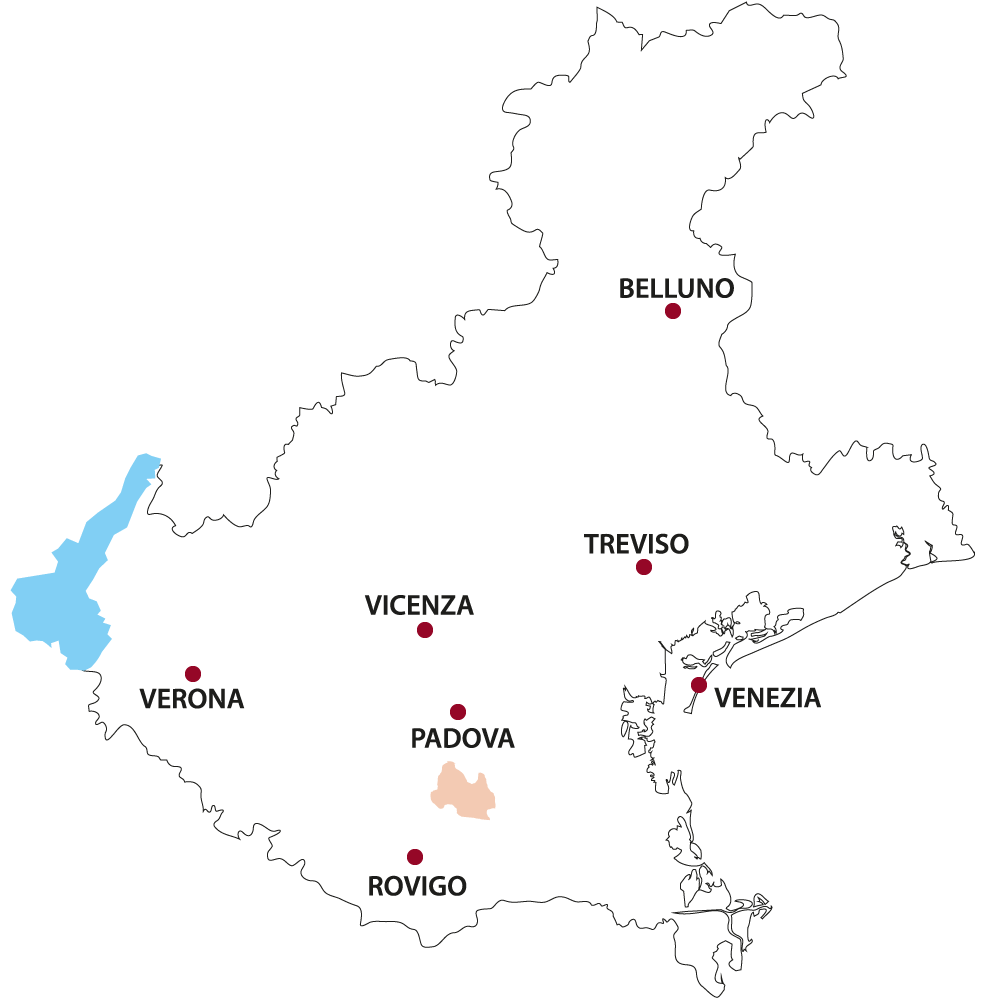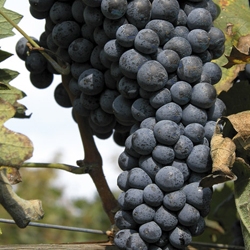

Zona di produzione
Viticulture in the southern area of the Province of Padua has ancient origins that go back to the Roman era, when Pliny the Elder attributed the particular flavour of wines to the custom of training the vine to the willow: “mira vitium natura saporem alienum in se trabendi, quare et salicem redolent Patavinorum in vindimiae”. (Naturalis Historia, XIV, 16). The earliest documentary evidence dates back to the year 954: it is a deed of donation of the “Bagnoli Dominion” with its vineyards and wine cellars that the Longobard Marquis Almerigo made to the Benedictine monks. In the following centuries the Benedictine administration gave a strong impetus to the development of viticulture, which continued under the dominion of the Serenissima. The Vin Friularo was already at that time among the most appreciated wines of this terroir: “no ga vini el Benintendi del Friularo più preziosi” – “there is no wine that is more precious than Friularo” (Ditirambo about vin Friularo, Ludovico Pastò, 1788); it was shipped on vessels as “Vin da Viajo” (wine for travel) and transported to the colonies and the Veneto embassies. To this day the Vin Friularo Bagnoli represents the pride of the area along with a number of other white wines and spumante wines that complete the varied production. The territory of the D.O.C. Bagnoli includes the Municipalities of Agna, Arre, Bagnoli di Sopra, Battaglia Terme, Bovolenta, Candiana, Due Carrare, Cartura, Conselve, Monselice, Pernumia, S. Pietro Viminario, Terrassa Padovana and Tribano. The D.O.C. “Classic” area is limited to the Municipality of Bagnoli di Sopra.
Caratteristiche e tipologie vino
Bagnoli Friularo D.O.C.G.: Vin Friularo is the symbol of the Bagnolese tradition and it is a structured and full-bodied red wine that has a strong fruity bouquet of wild cherries. The “Riserva” version, obtained by long aging in wooden casks, has a spicy bouquet of tobacco, pepper and cinnamon. The large and compact bunch with tight berries with thick skin is particularly suitable for ripening on the plant or withering in drying lofts. It is through these processes that we obtain the “Late Harvest” and “Passito” types where the olfactory complexity and the structure reach the maximum expression in a pleasant combination of intensity, bouquet and seductive sweetness. Bagnoli Spumante D.O.C.: The Friularo grapes can also be vinified in the white version and in this case we have a straw yellow coloured wine, fresh with a mineral touch that is used as the base for the production of the Bianco Spumante D.O.C. Bagnoli. D.O.C. Bagnoli Wines: The production regulation includes other red, white and rosé wines. The single-varietal wines are Cabernet and Merlot, Refosco dal peduncolo rosso, Corbina, Cavrara, Turchetta, Marzemina Bianca; the Rosso (red) and Rosato (rosé) are grape varieties obtained from the three main vines, Friularo, Cabernet and Merlot together with Carmenére; the white wine is obtained from the Chardonnay, Sauvignon Blanc vines together with a small percentage of Friularo vinified in white.
Grapes
-

FRIULARO
The Friularo is an autochthonous vine that belongs to the Raboso genre. The origin and the etymology of the word are uncertain but the most accredited version is that it derives from “frigus”, cold, that refers to the late ripening of the grapes. The late harvest takes place in fact during the second half of November, after the so-called “Summer of S. Martin”, when it is cold. Other vines in the territory that are well appreciated are some autochthonous ones that have a modest productive relevance and some international vines that were widely grown during the course of the 1900s when the scourge of phylloxera seriously threatened the entire viticulture in Veneto. Merlot, Cabernet and Chardonnay prove to be particularly adequate for the climate in lower Veneto and represent a significant part of the local production to this day.
White Wines
BAGNOLI D.O.C. BIANCO
Colour: intense straw-like yellow with greenish reflections when young and tending to golden yellow with aging;
Bouquet: white pulp and exotic fruit aromas with hints of peach, apricot and floral
Taste: dry, intense, smooth, harmonic and wellbalanced;
Alcoholic Strength minimum total volume: 10,50%
Accompaniments: as an aperitif, vegetable risottos, fish, white meats, fresh pasta, mixed fried foods, fresh cheeses.
BAGNOLI D.O.C. SPUMANTE BRUT
Colour: pale straw yellow with greenish reflections when young and tending to golden yellow when elaborated with the Classic method and with aging;
Bouquet: fragrant and mineral with characteristic notes of peach and hydrocarbons;
Taste: dry, quite smooth, fresh, well-balanced
Alcoholic Strength minimum total volume: 10,50%
Accompaniments: as an aperitif, seafood, crustaceans, boiled fish with delicate sauces, fresh and aged cheeses, all courses.
Red Wines
BAGNOLI FRIULARO D.O.C.G. E FRIULARO RISERVA D.O.C.G.
Colour: deep ruby red, tending to purple when young, it acquires garnet reflections with prolonged refining in the bottle or in the Reserve type
Bouquet: vinous, marked fragrance, with scents of wild cherries and violet and hints of vanilla, tobacco, cinnamon, as it ages in wooden casks
Taste: dry, austere, properly tannic, fresh and slightly tangy;
Alcoholic Strength minimum total volume: 11.5% vol., 12.5% vol. in the Reserve version
Accompaniments: minced meat first courses, game, large roasts, cold cooked pork meats, braised meats, stew dishes, wild game, hard cheeses
BAGNOLI FRIULARO VENDEMMIA TARDIVA D.O.C.G.
Colour: deep ruby red, with garnet reflections
Bouquet: complex and intense, with scents of wild cherries, over-ripe fruit and notes of tobacco, cocoa and leather;
Taste: structured, expressive and harmonious, softly tannic
Alcoholic Strength minimum total volume: 12,5% vol.
Accompaniments: large roasts, matured cold cuts, braised and stewed meats, wild game, blueveined cheeses and aged cheeses
BAGNOLI FRIULARO PASSITO D.O.C.G.
Colour: deep ruby red, with garnet reflections
Bouquet: spiced and elegant
Taste: sweetish, warm, persistent, velvety and typically acidic
Alcoholic Strength minimum total volume: 15,5% vol.;
Accompaniments: wine for contemplation and for the end of the meal, suitable with sweets, plum tarts or red fruit jam tarts, dry or chocolate pastries and soft aged cheeses or strong cheeses
BAGNOLI D.O.C. ROSSO
Colour: deep ruby red, tending to purple when young, gains garnet reflections with prolonged refinements in bottles or in the Reserve type
Bouquet: vinous, quite intense, pleasant hint, mineral notes, sulphurous, slightly peaty
Taste: dry, persistent, velvety and well-balanced
Alcoholic Strength minimum total volume: 11% vol., 12% vol. in the Reserve type
Accompaniments: flans, meat risottos, grilled red meats large roasts, game and hard cheeses
BAGNOLI D.O.C. MERLOT
Colour: bright ruby red, tending to purple when young, gains garnet reflections with prolonged refining in bottle or in the Reserve type;
Bouquet: intense, fruity, with notes of red fruit, plum, cherry, flowers, sweet violet, characteristic
Taste: dry, smooth, correctly tannic, harmonic
Alcoholic Strength minimum total volume: 11% vol., 12% vol. in the Reserve type
Accompaniments: pasta, red meats, grilled meats, fine poultry, omelettes, soft cheeses
BAGNOLI D.O.C. CABERNET
Colour: bright ruby red, tending to purple when young, gains garnet reflections with prolonged refining in bottle or in the Reserve type;
Bouquet: vinous, characteristic, more intense if aged, herbaceous, with notes of green capsicum and berries;
Taste: dry, full, well-balanced, tannic, full bodied, tends to austere and to velvety with aging
Alcoholic Strength minimum total volume: 11% vol., 12% vol. in the Reserve type
Accompaniments: pasta with sauces, roasts, stewed meats, oven-cooked fine poultry, feather game, aged cheeses.
BAGNOLI D.O.C. VIN DA VIAJO
Colour: intense ruby red with garnet reflections
Bouquet: ethereal, spicy and intense
Taste: warm, persistent, velvety, amiable to sweet
Alcoholic Strength minimum total volume: 15,5% vol.;
Accompaniments: a wine for meditation and after meals, suitable to accompany dry pastries and dark chocolate.
VINI ROSATI
BAGNOLI D.O.C. ROSATO
Colour: pink tending to live ruby when young, it acquires orangey reflections with maturity
Bouquet: slightly vinous, floral, pleasant
Taste: dry, intense, quite fresh and pungent
Alcoholic Strength minimum total volume: 10,50%
Accompaniments: light starters, pasta, vegetable risottos, white meats, tripe, fried fish and soft cheeses.

